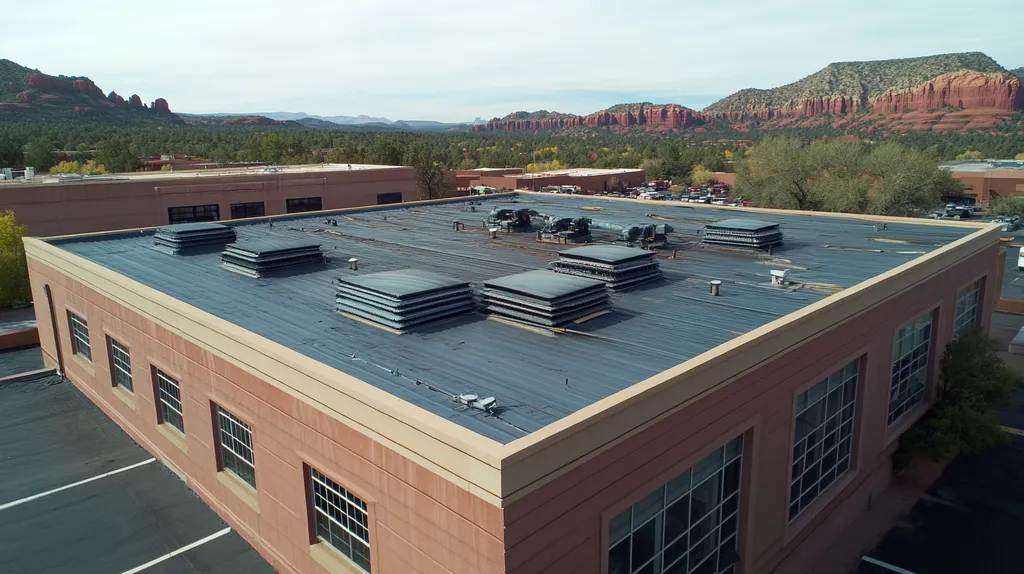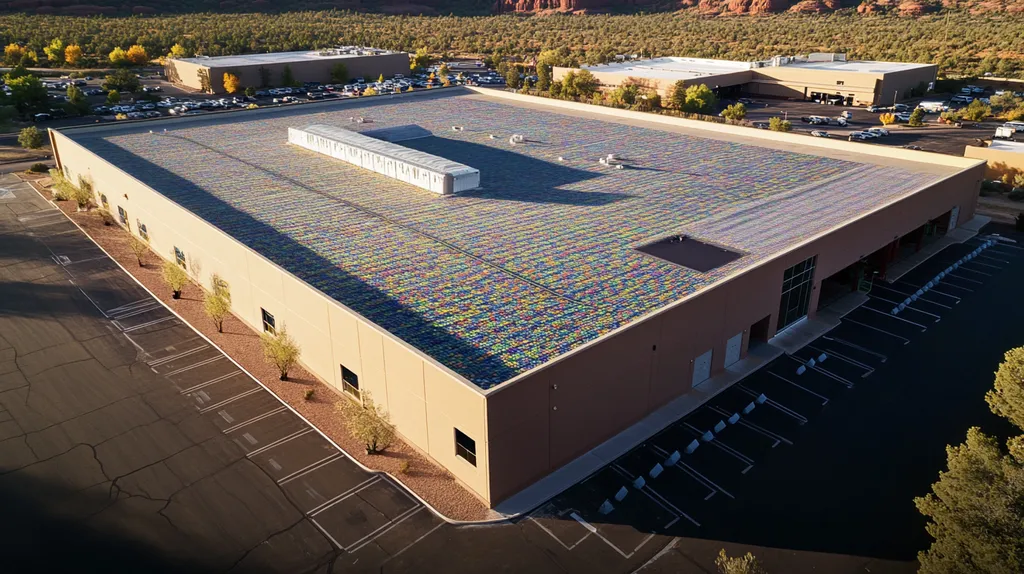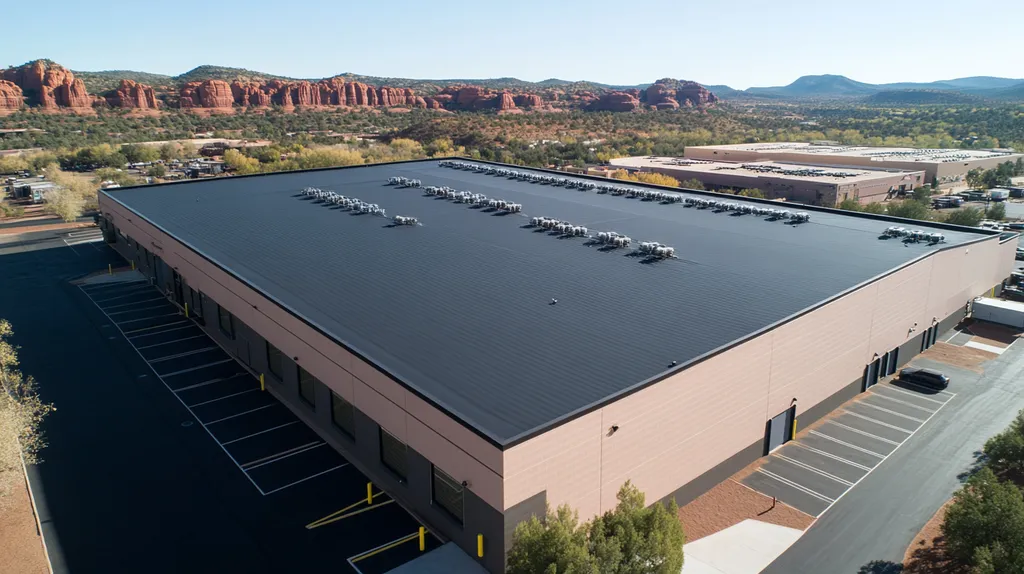With landfills reaching capacity and disposal costs skyrocketing, commercial property owners face mounting pressure to address the 15 million tons of roofing waste generated annually in the United States.
While recycling old roofing materials offers significant environmental and financial benefits, the process requires careful planning and execution to ensure success.
This comprehensive guide examines critical factors property professionals must consider, from assessing material integrity and coordinating logistics to navigating compliance requirements and managing associated risks.
By following these actionable guidelines, facility managers can implement effective recycling programs that reduce waste, control costs, and support sustainability goals.
SECTION 1: PERFORMANCE FACTORS
With increasing pressure to adopt sustainable building practices, property owners must navigate the complexities of managing aging roofing materials responsibly. Alarmingly, over 15 million tons of roofing waste are discharged into U.S. landfills each year. By recycling materials from old commercial roofs, property managers can significantly reduce their environmental footprint while also improving the performance of their buildings. This section outlines critical factors to consider, such as assessing material integrity, understanding recycling’s impact on roof longevity, and evaluating how recycled materials interact with new roofing systems.
Assessing Material Integrity in Old Roof Components
Before pursuing recycling options, it’s essential to evaluate the integrity of existing roofing materials. Comprehensive inspections should be performed to detect any signs of damage, deterioration, or weakness in components like membranes, insulation, and flashing. These elements can degrade over time, significantly impacting their effectiveness.
For example, a seemingly intact roof membrane might conceal hidden moisture damage that can lead to mold growth or structural issues. Engaging qualified roofing professionals to assess the integrity of these components is crucial for determining their suitability for recycling.
Materials such as thermoplastics and rubber can often be recycled if they remain in good condition. However, severely worn materials should not be reused, as they could undermine the performance of the new roofing system. Taking the time to ensure a thorough evaluation empowers property owners to make informed recycling choices and bolsters the sustainability of their roofing projects.
Key Action Items
Impact of Recycling on Roof Longevity and Function
The process of recycling roofing materials can significantly enhance both the lifespan and functionality of new roofing systems. When old materials are skillfully processed and integrated into new projects, they often bring benefits such as improved thermal performance and a lower environmental impact.
For example, using recycled insulation materials can lead to enhanced energy efficiency, resulting in reduced heating and cooling costs for property owners. Furthermore, many manufacturers committed to sustainable practices produce these recycled products, supporting the development of an eco-friendly supply chain.
Despite these advantages, it’s critical to evaluate potential risks concerning quality. Property managers should ensure that recycled materials align with relevant industry standards and regulations to sustain roof integrity. When done correctly, recycling strategies can lead to reduced operational costs while simultaneously enhancing roofing performance.
Key Action Items
Evaluating Compatibility of Recycled Materials with New Systems
The compatibility of recycled materials with the new roofing systems is a critical factor that should not be overlooked. Each roofing installation comes with specific demands influenced by climate, building usage, and current structures.
Before committing to the use of recycled components, property professionals must assess their compatibility with the selected new roofing system. This evaluation includes factors like weight, flexibility, and specific material characteristics to ensure optimal performance.
For instance, a lightweight recycled membrane may fail to provide equivalent structural support when compared to a traditional option. Therefore, consulting roofing experts and manufacturers is essential to determine how recycled materials fit with project objectives. Missteps in material selection can lead to premature roof failure, higher maintenance expenses, and potentially hazardous conditions for building occupants. Ensuring compatibility not only maximizes the environmental advantages of recycling but also solidifies the long-term success of the roofing project.
Key Action Items
SECTION 2: FINANCIAL CONSIDERATIONS
As the urgency for commercial property owners to embrace sustainable practices increases, the financial implications of recycling roofing materials become paramount. Construction and demolition debris accounts for nearly 30% of landfill waste, as reported by the EPA. Recognizing the financial benefits of recycling old roof materials can lead to reduced landfill contributions and substantial cost savings. A comprehensive analysis of investment versus long-term returns is essential for developing a successful and eco-friendly roofing strategy.
Cost-Benefit Analysis of Roof Material Recycling
Understanding the cost-effectiveness of recycling old roofing materials is integral to making informed decisions. Although the initial costs may be higher, the long-term financial benefits often outweigh these expenses. For example, recycled materials frequently come at a lower price for new roofing systems, resulting in significant savings for property owners.
Additionally, using recycled materials can boost the durability of new roofs, ultimately lowering maintenance expenses. A roof that is well-maintained not only lasts longer but also reduces the need for frequent repairs and replacements, effectively increasing budget efficiency.
Cities and municipalities often provide incentives or grants to encourage recycling initiatives, enhancing the financial feasibility of such projects. Staying informed about these programs can lower upfront costs, making it crucial for property owners to seek out applicable opportunities.
Key Action Items
Savings from Reduced Waste Disposal and Landfill Fees
Expenses related to waste disposal for commercial roofing projects can escalate quickly, making it crucial for property owners to explore alternatives. Many landfills charge fees based on the weight or volume of waste, leading to considerable costs. By recycling old roofing materials, property owners can effectively reduce these expenses.
For instance, a typical commercial roofing project may generate thousands of pounds of waste. By diverting this waste for recycling, substantial savings on landfill fees can be achieved, significantly benefiting the bottom line while minimizing environmental impact.
Recycling can also bolster a company’s reputation, as many clients prefer to engage with environmentally responsible businesses. This positive perception can lead to increased customer loyalty, further enhancing profits. Contractors and waste management companies frequently offer lower rates for recycling than for standard disposal, making it easier to select roofing contractors who support green initiatives.
Key Action Items
Budgeting for Recycling Logistics and Labor Expenses
Incorporating recycling logistics into roofing project budgets is vital. Property owners need to account for expenses tied to transporting materials to recycling facilities, which can fluctuate based on distance and the volume of materials involved.
Labor costs are another important factor. Recycling roofing materials often requires specialized labor, as certain materials must be handled with care. While hiring experienced workers may seem costly initially, their expertise can result in long-term savings by ensuring that the recycling process is executed efficiently.
Selecting a contractor experienced in recycling can help streamline both logistics and labor expenses. These contractors commonly have established connections with local recyclers, facilitating smoother operations and potentially reducing costs.
Comprehensive budgeting that encompasses logistics, labor, and material disposal is critical for precise financial projections. A proactive approach to these considerations allows property owners to make informed financial decisions as they implement effective recycling practices.
Key Action Items
SECTION 3: COMPLIANCE REQUIREMENTS
Ensuring compliance with waste management regulations is essential for property owners looking to recycle materials from aging commercial roofs. With the Environmental Protection Agency (EPA) indicating that construction and demolition debris occupies nearly 25% of landfill space, awareness of these regulations is critical. Property managers must navigate both federal and state laws to avoid significant fines while fostering sustainable practices.
Understanding Federal and State Waste Management Regulations
Federal and state waste management regulations dictate how roofing materials should be processed during recycling. The Resource Conservation and Recovery Act (RCRA) sets essential waste management standards specifically for construction debris, emphasizing safe disposal and recycling methods. Property professionals should also familiarize themselves with local laws, which can differ greatly from one area to another.
Some states mandate specific recycling quotas for roofing materials, requiring property owners to recycle or reuse a designated percentage. Ignoring these regulations can lead to serious financial penalties and undermine environmental commitments.
Partnering with reputable waste management companies can simplify compliance, as these firms possess the knowledge to navigate complex regulations effectively.
Key Action Items
Certifications and Standards for Recycled Roofing Materials
When using recycled roofing materials, adherence to various certifications and industry standards is necessary. Many of these products must comply with guidelines set forth by organizations like the American Society for Testing and Materials (ASTM), which ensures all materials meet safety and performance criteria.
For instance, roofing materials often require testing for durability, fire resistance, and weatherability before securing certifications. Utilizing certified products enhances a property’s credibility and mitigates liability risks.
Property managers should thoroughly verify supplier certifications to guarantee material compliance with established standards. This diligence reinforces sustainability claims and attracts environmentally-conscious tenants.
Key Action Items
Documentation and Reporting for Environmental Compliance
Accurate documentation is paramount for demonstrating compliance with environmental regulations. Property professionals should maintain detailed records of all recycling activities, including the types of materials, quantities, and disposal methods used during a roofing project.
Regular reporting is often mandated by state laws, requiring property owners to submit comprehensive documentation outlining their waste management practices. Lack of proper records can result in hefty fines and legal challenges.
Implementing a tracking system, either through digital logs or specialized software, can facilitate smoother documentation and streamline compliance efforts. Having meticulous records not only meets regulatory requirements but also showcases commitment to sustainability.
Key Action Items
SECTION 4: RISK MANAGEMENT
Property professionals must prioritize risk management when recycling materials from old commercial roofs. Failing to handle reused materials correctly can lead to structural failures, legal liabilities, and health hazards. Alarmingly, nearly 30% of commercial buildings face structural risks due to inadequate assessment of reused components. This section will delve into crucial areas that warrant attention, including identifying structural risks, establishing health and safety protocols, and mitigating potential legal and environmental liabilities.
Identifying Structural Risks from Reused Materials
Improperly assessing structural risks of reused roofing materials can have severe consequences. Property managers must thoroughly evaluate the integrity of materials, such as membranes and decking, to ensure they remain viable. Weathering and rot can compromise older materials that seem sound at first glance.
Furthermore, mismatches between new and reused materials can lead to roof system failures, such as leaks caused by differing thermal expansion rates. Proper inspections and load assessments are critical to ensure these materials can meet current building codes.
Engaging qualified professionals to conduct thorough evaluations can significantly reduce the likelihood of misjudgments. Their expertise can guide the identification of engineered solutions to enhance reused materials, ensuring compliance and safety. Ignoring these assessments may lead to costly repairs or even total roof replacement, diminishing the overall investment.
Key Action Items
Health and Safety Protocols during Roof Removal and Recycling
Implementing effective health and safety protocols is crucial during the removal and recycling of old roofing materials. Workers may encounter hazardous materials, such as asbestos or harmful chemicals, commonly found in outdated roofs. Conducting thorough assessments before removal can help identify these risks.
Establishing safety guidelines, including requirements for personal protective equipment (PPE), is essential to minimize exposure risks. Using respirators, gloves, and protective eyewear can safeguard workers while handling materials. Additionally, training teams on emergency procedures prepares them for unforeseen incidents.
Proper disposal methods for hazardous materials must be in place to adhere to local regulations, avoiding fines and additional safety issues. Commitment to safety in the workplace fosters a culture of accountability and demonstrates compliance with safety standards.
Key Action Items
Mitigating Legal and Environmental Liabilities
Property owners must take legal and environmental liabilities into account when recycling roofing materials. Non-compliance with local regulations can lead to significant fines and legal challenges. A clear understanding of national and local laws regarding recycling and hazardous waste disposal is essential.
Many jurisdictions mandate documentation of recycling processes. Keeping detailed records not only demonstrates due diligence but also provides protection against potential litigation. Each record should document the origin of materials and their intended reuse.
Considering environmental impact is vital. Employing sustainable practices reduces the environmental footprint and enhances public reputation. Partnering with certified recycling companies ensures responsible processing of materials.
Key Action Items
SECTION 5: OPERATIONAL PROCEDURES
Recycling materials from old commercial roofs requires a structured approach to maximize efficiency and minimize waste. With construction waste accounting for nearly 30% of landfill material, property owners must develop meticulous operational procedures. By focusing on systematic inspections, effective logistics coordination, and diligent tracking of recycling outcomes, property managers can ensure sustainable and cost-effective roofing solutions.
Systematic Inspection and Sorting of Tear-Off Materials
The journey toward effective recycling starts with a thorough inspection of the roof before any demolition takes place. Property managers should identify roofing materials like TPO, PVC, or EPDM to assess their recycling potential accurately. Understanding these materials will shape a successful recycling strategy.
On-site sorting of materials as they are removed is critical. By categorizing components such as metal flashing, rubber membranes, and insulation into different streams, property professionals can enhance the recycling process. This method not only boosts operational efficiency but also ensures compliance with waste disposal regulations.
Engaging roofing contractors with recycling expertise can provide valuable insights into efficient sorting practices. Their knowledge can help ensure that recoverable materials are not accidentally discarded. Additionally, documenting sorted materials allows for an assessment of recycling quantities, benefiting future projects and compliance reporting.
Key Action Items
Coordinating Recycling Logistics with Contractors and Facilities
Once materials have been sorted, effective logistics planning becomes essential. Property owners need to collaborate with roofing contractors to develop a comprehensive recycling plan that outlines timelines, transportation methods, and disposal facilities specifically designed for roofing materials.
Clear communication with contractors is vital to ensure that recycling goals are understood and met. Exploring each contractor’s capabilities can streamline the recycling process. For instance, contractors may already have partnerships with recycling vendors, simplifying material recovery.
Additionally, establishing a consistent pickup schedule prevents material accumulation on-site, which can lead to operational inefficiencies. Engaging a reliable recycling partner capable of adjusting to varying demands ensures a smooth workflow. Regular check-ins throughout the project can help tackle any emerging logistical hurdles.
Key Action Items
Tracking and Verifying Recycling Processes and Outcomes
Effective tracking of the recycling process is imperative for assessing the success of operational procedures. Property owners should implement a monitoring system to track the volume of materials sent for recycling. This practice not only highlights successful outcomes but also generates valuable data for future initiatives.
Prioritizing the verification of recycling outcomes is equally important. Requesting recycling certificates from contractors serves as documented evidence of materials diverted from landfills, reinforcing compliance with sustainability objectives and regulations.
Analyzing the collected data can illuminate trends and areas for improvement in future recycling efforts. Quantifying the recycling success rate helps inform strategic choices moving forward. Sharing these insights with stakeholders fosters a culture of sustainability and underscores commitment to responsible operational practices.
Key Action Items
SECTION 5: OPERATIONAL PROCEDURES
Recycling materials from old commercial roofs is not just an environmentally friendly choice; it demands a well-structured approach. With nearly 30% of all landfill materials attributed to construction waste, property owners must adopt meticulous operational procedures. These practices can minimize waste, enhance sustainability, and potentially lower disposal costs. This section outlines the key steps, including systematic inspections, logistics coordination, and tracking recycling outcomes.
Systematic Inspection and Sorting of Tear-Off Materials
The recycling process begins with a thorough inspection of the roof prior to any removals. Property managers should pinpoint the roofing materials in place, such as TPO, PVC, or EPDM, to evaluate their recycling potential. A solid understanding of these materials can heavily influence the recycling strategy’s success.
On-site sorting during the tear-off phase is essential. By categorizing materials—such as metal flashing, rubber membranes, and insulation—professionals can streamline recycling efforts. This method not only enhances operational efficiency but also ensures adherence to local waste disposal regulations.
Engaging experienced roofing contractors familiar with recycling methods can provide valuable insights and techniques for effective sorting. They can help prevent discarded valuable materials from ending up in landfills. Documenting sorted materials further supports compliance tracking and future project assessments.
Key Action Items
Coordinating Recycling Logistics with Contractors and Facilities
After sorting, the next step is strategic logistical planning. Property owners should collaborate with roofing contractors to craft a detailed recycling plan. This plan needs to outline timelines, transportation methods, and designated disposal facilities that accept roofing materials.
Open communication during this phase is crucial to align everyone on recycling objectives. Understanding each contractor’s resources can lead to smoother logistics; many may already have ties with recycling firms, simplifying material recovery.
Establishing a regular pickup schedule is key to avoiding accumulation of materials on-site, which could hamper efficiency. Selecting a reliable recycling partner who can adjust to fluctuating needs will facilitate a seamless operation. Regular check-ins throughout the project timeline can help ensure logistics remain on track.
Key Action Items
Tracking and Verifying Recycling Processes and Outcomes
Monitoring the recycling process is vital to assess the effectiveness of the operational procedures. Property owners should implement a tracking system to accurately record the volume of materials diverted for recycling. This practice not only signifies success but also delivers important data for future initiatives.
Verification is equally critical; requesting recycling certificates from contractors provides proof of materials salvaged from landfills. This documentation is essential for demonstrating compliance with sustainability targets and local regulations.
Moreover, analyzing the gathered data can reveal trends and highlight areas for future improvement. Understanding how much was recycled in comparison to disposed materials is key for strategic planning. Sharing these insights with stakeholders fosters a culture of sustainability, reinforcing responsible management practices.
Key Action Items
Looking Ahead
With landfills reaching critical capacity and disposal costs rising 15% annually, property owners can no longer afford to ignore roofing material recycling opportunities.
The data clearly shows that implementing comprehensive recycling programs reduces waste management expenses by 30-40% while supporting essential sustainability goals.
Success requires careful attention to material integrity assessment, regulatory compliance, risk management protocols, and systematic operational procedures.
By following the guidelines and checklists outlined in this resource, property professionals can effectively navigate the complexities of roof recycling while realizing both environmental and financial benefits.
The future of commercial roofing lies in sustainable practices – those who adapt early will gain competitive advantages in an increasingly environmentally conscious market.
FREQUENTLY ASKED QUESTIONS
Q. How do I assess the integrity of my commercial roof?
A. Start by scheduling a comprehensive inspection with qualified roofing professionals. They can identify any damage or deterioration in roofing materials, crucial for determining recycling options. Look for signs like moisture damage, which can compromise effectiveness, ensuring materials are suitable for reuse.
Q. What financial benefits can recycling my old industrial roof provide?
A. Recycling can reduce costs by lessening landfill fees and utilizing lower-priced recycled materials. Long-term durability of recycled products often leads to lower maintenance expenses over time, offering significant savings for property owners.
Q. What waste management regulations must I consider for my commercial roof?
A. Familiarize yourself with federal and state waste management regulations, particularly the Resource Conservation and Recovery Act. Understanding local laws is crucial, as many areas mandate specific recycling quotas for roofing materials to avoid penalties.
Q. How do I assess structural risks associated with reused roofing materials?
A. Conduct thorough evaluations of the integrity of reused materials, such as membranes and decking. Engage professionals to identify potential issues like weathering or structural mismatches to prevent system failures and ensure compliance with current building codes.
Q. What operational procedures should I implement for recycling roof materials?
A. Start with systematic inspections and on-site sorting of materials during removal. Create a detailed logistics plan with contractors for recycling and ensure consistent documentation of materials for compliance and future assessments.
Q. How can I ensure my recycled roofing materials meet compliance standards?
A. Verify that suppliers provide materials conforming to relevant certifications like ASTM standards. Stay informed on certifications and document all materials used to reinforce your commitment to sustainability and compliance.
Q. What are the long-term impacts of recycling materials from my commercial roof?
A. Long-term impacts include reduced landfill contributions, cost savings, and enhanced roof longevity due to quality recycling practices. By adopting a sustainable approach, property owners can improve their environmental footprint and promote positive public perception.










